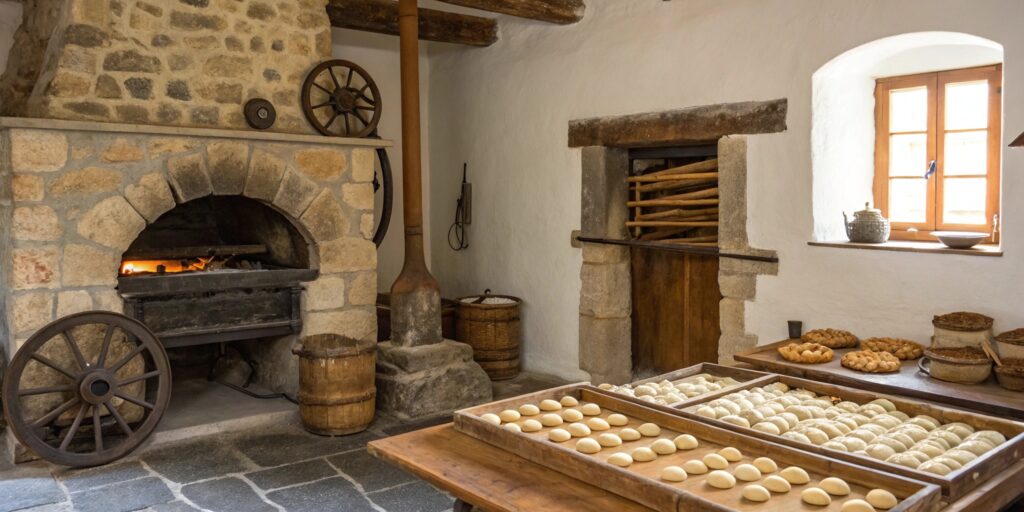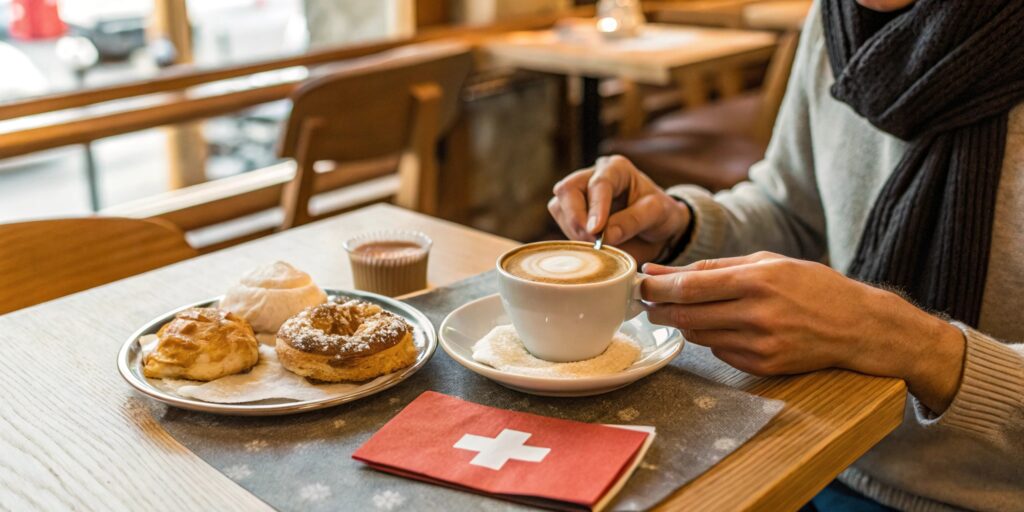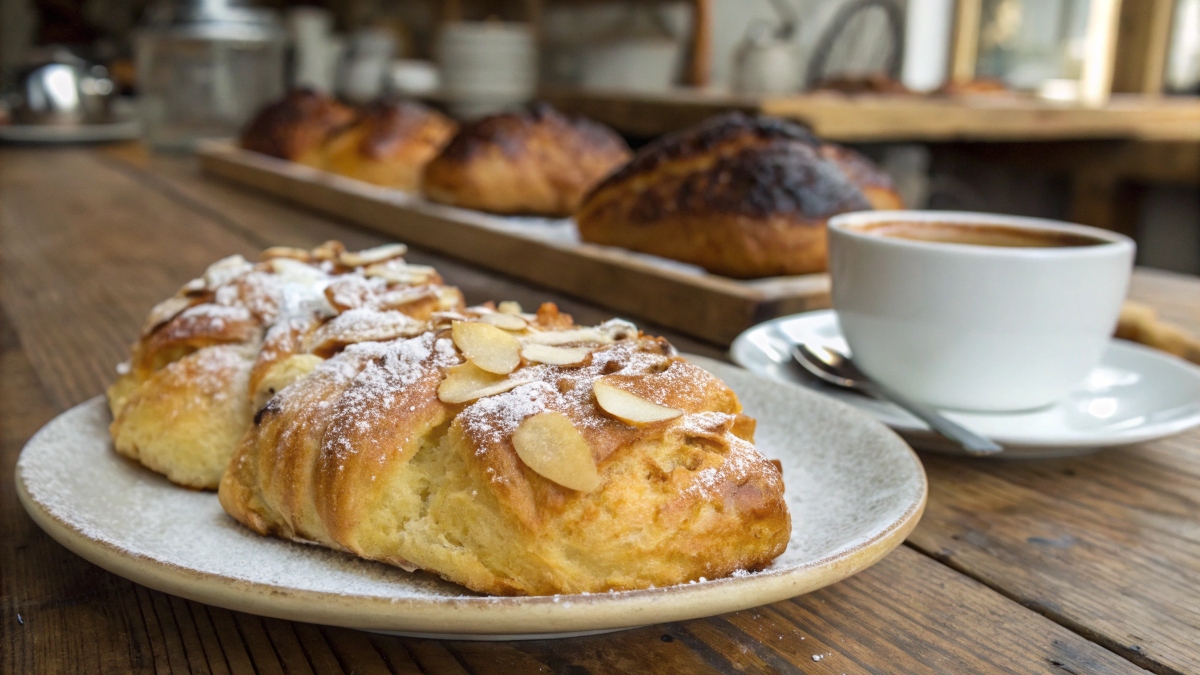If you love pastries, especially those with a buttery, flaky texture and a rich almond flavor, you may have come across Mandelgipfel. But what is it exactly? To clarify, this Swiss and Austrian pastry is a delightful almond crescent, similar to a croissant yet uniquely its own. Originating in Central Europe, it has long been a bakery staple. Moreover, it has captivated pastry lovers for generations.
The Origins of Mandelgipfel

The name “Mandelgipfel” combines two German words: “Mandel,” meaning almond, and “Gipfel,” meaning peak or crescent. In other words, its name reflects both its ingredients and its shape. This traditional pastry is a close relative of the Austrian Kipferl and shares similarities with the French almond croissant. However, it has distinct characteristics that set it apart.
Switzerland’s Love for Almond Pastries
Switzerland has a long history of pastry-making, and, significantly, almonds play a major role in its confectionery culture. Many classic Swiss desserts, such as Basler Läckerli and Engadiner Nusstorte, prominently feature almonds. Similarly, it is a favorite among locals. Notably, it is often enjoyed with a warm cup of coffee or tea in the morning or as an afternoon treat.
Austrian Influence on the Recipe
Mandelgipfel’s roots can be traced back to Austria, where the iconic Kipferl was first created. To put it into perspective, the Kipferl is the predecessor to the modern-day croissant and dates back to the 17th century. While the French later refined the croissant with layers of laminated dough, the Austrian Kipferl remained a simpler, crescent-shaped pastry. Additionally, it was often coated in nuts or sugar. Consequently, this influence led to the evolution of Mandelgipfel, which retains the Kipferl’s rustic appeal while incorporating a generous coating of sliced almonds and a slightly crisp exterior.
What Makes a Mandelgipfel Unique?
Though it shares similarities with other almond pastries, Mandelgipfel stands out due to its texture, shape, and almond coating. Unlike croissants, which have delicate, laminated layers, Mandelgipfel is made with a dough that is denser, yet still tender, providing a satisfying bite.
Ingredients That Define a Mandelgipfel
Clearly, the hallmark of an authentic Mandelgipfel is its rich almond flavor and slightly crunchy exterior. The key ingredients include:
- Butter – Essential for a rich and flaky texture.
- Almonds – Used in both ground and sliced form for flavor and crunch.
- Flour – A high-quality flour ensures the dough’s elasticity.
- Sugar – A touch of sweetness balances the nuttiness of almonds.
- Eggs – Provide structure and contribute to the golden crust.
These simple ingredients, when combined, create a pastry that is both rustic and elegant.
The Crescent Shape & Its Significance
It is important to realize that the crescent shape of Mandelgipfel is not just aesthetic—it also has historical and cultural significance. In Austrian and German baking traditions, crescent-shaped pastries symbolize prosperity and good luck. Furthermore, some historians believe that the shape was inspired by the Ottoman crescent, following the Austro-Turkish wars, much like the origins of the Kipferl and croissant.
How Mandelgipfel Differs from Other Pastries
Mandelgipfel is often compared to similar pastries, yet it has unique qualities that distinguish it from other almond-based treats.
Croissant vs. Mandelgipfel – Key Differences
Many people wonder: What is the difference between a croissant and a gipfeli? Likewise, the same question applies to Mandelgipfel. Unlike croissants, which are made with laminated dough and baked until golden brown, Mandelgipfel is denser and has a crunchier texture due to its almond coating.
Mandelgipfel vs. Gipfeli – Are They the Same?
Swiss bakeries often offer both Gipfeli and Mandelgipfel, which, understandably, leads to some confusion. To clarify, Gipfeli refers to the Swiss version of a croissant. Meanwhile, Mandelgipfel is a variation that includes an almond-encrusted exterior, giving it an extra layer of flavor and texture.
Comparing Mandelgipfel to Almond Croissants
Almond croissants are well-known for their creamy almond filling and sugar-dusted exterior. In contrast, Mandelgipfel does not typically contain an almond paste filling. Instead, it relies on the natural flavor of almonds and a buttery dough to create a balanced, nutty pastry.
Conclusion
In summary, Mandelgipfel is a pastry steeped in history, combining elements of Swiss and Austrian baking traditions. Its crunchy almond coating, rich buttery flavor, and iconic crescent shape make it a favorite treat across Europe. Whether you’re enjoying it with coffee in a Swiss café or baking it at home, this delightful pastry is, without a doubt, a must-try for almond lovers.
Classic Mandelgipfel Recipe
Making Mandelgipfel at home is easier than you might think! In fact, this classic recipe ensures a perfect balance of buttery, flaky dough and a crunchy almond topping. Below, you’ll find a step-by-step guide to creating your own delicious Swiss almond crescents. Furthermore, by following these instructions carefully, you’ll achieve bakery-quality results.
Essential Ingredients for Mandelgipfel
To achieve the perfect texture and flavor, it is essential to use high-quality ingredients. Here’s exactly what you’ll need:
| Ingredient | Quantity |
|---|---|
| All-purpose flour | 250g (2 cups) |
| Butter (cold, cubed) | 125g (1/2 cup) |
| Granulated sugar | 50g (1/4 cup) |
| Almond flour | 60g (1/2 cup) |
| Egg yolk | 1 large |
| Milk | 50ml (3 tbsp) |
| Vanilla extract | 1 tsp |
| Sliced almonds | 100g (1 cup) |
| Powdered sugar (for dusting) | As needed |
Step-by-Step Baking Instructions
Follow these steps carefully to make the perfect Mandelgipfel:
- Prepare the dough: First, in a large bowl, mix the flour, sugar, and almond flour. Then, add the cold butter and rub it into the flour until the mixture resembles coarse crumbs.
- Combine wet ingredients: Meanwhile, in a separate bowl, whisk the egg yolk, milk, and vanilla extract together. Gradually add this to the flour mixture and knead until a smooth dough forms.
- Chill the dough: Next, wrap the dough in plastic wrap and refrigerate for at least 30 minutes. This step enhances its texture and makes it easier to shape.
- Shape the crescents: After chilling, roll out the dough on a lightly floured surface to about 5mm thickness. Then, cut into small triangles and roll each into a crescent shape.
- Coat with almonds: Brush the shaped dough with a little milk or egg wash and press sliced almonds onto the surface for extra crunch.
- Bake: Preheat your oven to 180°C (350°F). Meanwhile, place the Mandelgipfel on a baking sheet lined with parchment paper and bake for 15–18 minutes, or until golden brown.
- Cool and dust: Finally, let the pastries cool completely before dusting them with powdered sugar for a perfect finishing touch.
Tips for Perfect Mandelgipfel
Even experienced bakers can benefit from a few expert tips to ensure the best results. Additionally, these insights will help you avoid common mistakes.
Achieving the Flaky Texture
The key to a perfect Mandelgipfel lies in handling the dough properly. Specifically, follow these steps:
- Always use cold butter to maintain a flaky consistency.
- Additionally, avoid over-kneading the dough, as it should remain slightly soft and pliable.
- Moreover, chilling the dough before shaping helps maintain its structure and prevents spreading.
Best Almond Varieties to Use
The choice of almonds significantly impacts the flavor and texture of your Mandelgipfel. Consider the following options:
- Blanched almonds: Provide a milder taste and a smoother texture.
- Toasted almonds: Add a deeper, nutty flavor to the pastry.
- Thinly sliced almonds: Ensure even coverage and a delicate crunch.
Common Mistakes & How to Avoid Them
Making Mandelgipfel can sometimes lead to unexpected challenges. However, here’s how to fix common baking issues.
Why Is My Mandelgipfel Too Hard?
If your Mandelgipfel turns out too hard, consider these possible reasons:
- First, over-kneading the dough can develop too much gluten, making it tough.
- Second, not using enough butter can lead to a dry texture.
- Finally, baking at too high a temperature can cause excessive drying.
Preventing a Soggy Pastry Base
No one likes a soggy pastry! To avoid this issue, follow these guidelines:
- Ensure the oven is fully preheated before baking for even heat distribution.
- Additionally, use parchment paper to prevent direct contact with the baking sheet.
- Most importantly, place Mandelgipfel on a wire rack immediately after baking to prevent steam buildup.
Overbaking vs. Underbaking
Achieving the perfect golden-brown finish is essential. Keep these points in mind:
- Check your Mandelgipfel after 15 minutes—if it’s golden, it’s ready.
- If the almonds appear too dark, loosely cover them with foil while baking.
- Finally, let them cool completely before dusting with powdered sugar to prevent melting.
Conclusion
In conclusion, baking your own Mandelgipfel is a rewarding experience that fills your kitchen with the warm, nutty aroma of almonds and butter. Furthermore, by following this detailed recipe and troubleshooting guide, you’ll be able to create a batch of crispy, golden, and delicious Mandelgipfel that rivals those found in Swiss and Austrian bakeries.
Mandelgipfel in Swiss & Austrian Culture
Beyond its delicious taste, Mandelgipfel holds a special place in Swiss and Austrian culinary traditions. This almond pastry is commonly found in bakeries throughout Central Europe, where it is enjoyed as a breakfast staple or an afternoon treat.
Traditional Occasions & Celebrations
Mandelgipfel is not just an everyday pastry; it also plays a role in special occasions:
- Holiday feasts: Served during festive seasons such as Christmas markets in Switzerland and Austria.
- Coffee culture: Often paired with a strong espresso or a Swiss-style cappuccino in cozy cafes.
- Weekend indulgence: Many families buy freshly baked Mandelgipfel on weekends as a special breakfast treat.
Regional Variations of Mandelgipfel
Different regions have their own take on Mandelgipfel, giving it a unique twist:
- Swiss version: Typically less sweet, with a focus on buttery, flaky dough.
- Austrian variation: May include a light dusting of cinnamon for added warmth.
- German adaptation: Some bakeries fill them with marzipan or a sweet almond paste.
Best Ways to Enjoy Mandelgipfel

While delicious on its own, Mandelgipfel can be paired with a variety of beverages and even incorporated into desserts.
Coffee & Tea Pairings
If you’re a coffee lover, try enjoying Mandelgipfel with:
- A Swiss café crème (similar to an Americano but with a richer texture).
- A smooth Viennese melange (an espresso with foamed milk).
- A fragrant chai latte for a warm, spiced contrast.
Tea lovers can pair it with:
- Earl Grey: The citrusy notes complement the buttery pastry.
- Chamomile: A soothing option that balances the rich flavors.
- Almond-infused green tea: Enhances the nutty elements of Mandelgipfel.
Using Mandelgipfel in Desserts
If you have leftover Mandelgipfel, don’t let it go to waste! Here are some creative ways to repurpose it:
- Almond parfait: Crush pieces of Mandelgipfel and layer with yogurt and honey.
- Ice cream topping: Sprinkle crumbled Mandelgipfel over vanilla ice cream.
- French toast twist: Dip slices in an egg mixture and pan-fry for a luxurious breakfast.
Frequently Asked Questions About Mandelgipfel
Here are some common questions about Mandelgipfel to help you understand this pastry even better.
Is Mandelgipfel the Same as Gipfeli?
Not exactly! A Gipfeli is the Swiss equivalent of a croissant, often made with less butter and a slightly firmer texture. A Mandelgipfel, on the other hand, is coated in sliced almonds and has a richer, nutty flavor.
Can I Make Mandelgipfel Without Almonds?
Yes! If you have a nut allergy or prefer a different variation, you can:
- Use sesame seeds for a nut-free crunch.
- Replace almonds with coconut flakes for a tropical twist.
- Skip the nut topping entirely and brush with a sugar glaze.
What’s the Best Way to Store Mandelgipfel?
To keep it fresh, follow these storage tips:
- Room temperature: Store in an airtight container for up to 3 days.
- Refrigerator: Keeps fresh for up to a week, but may lose crispness.
- Freezer: Wrap individually in plastic wrap and freeze for up to 2 months.
Can I Reheat Mandelgipfel?
Absolutely! Reheat in an oven at 150°C (300°F) for 5 minutes to restore its crispy texture.
Are There Other Pastries Similar to Mandelgipfel?
Yes! If you enjoy it, you might also like:
- Croissants – Flakier and more buttery.
- Gipfeli – The Swiss version of a croissant.
- Almond biscotti – A crunchy Italian alternative.
Can I Make a Vegan Mandelgipfel?
Yes! Substitute:
- Butter with coconut oil or vegan butter.
- Egg yolk with a flaxseed or chia seed mixture.
- Milk with almond or oat milk.
Conclusion: Why You Should Try Mandelgipfel
it is more than just a pastry—it’s a piece of European culinary heritage. Whether you’re savoring it fresh from a Swiss bakery or baking it at home, its delightful crunch and rich almond flavor make it a must-try for pastry lovers.
Want to explore more delicious European pastries? Check out our Gipfeli recipe for another Swiss classic!

